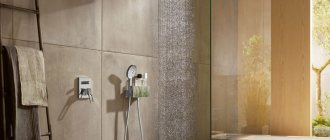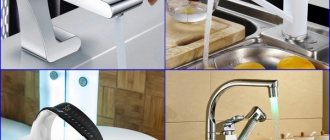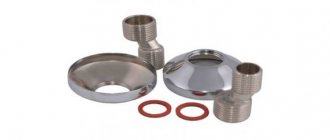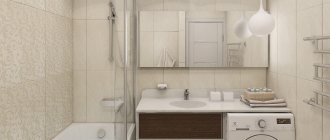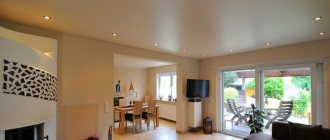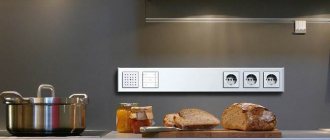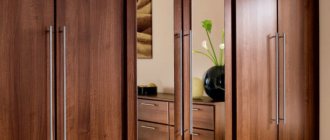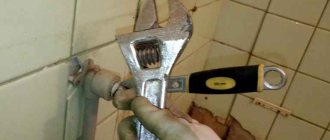One of the important stages when carrying out a major renovation in a bathroom is the installation of utilities to ensure cold and hot water supply. The design, including pipelines and taps, must meet several requirements at once: practicality, ease of use by all family members and aesthetics. The correctly selected height of the mixer above the bathtub will avoid splashes on the surfaces of walls, floors and plumbing, ensure comfortable use of the device and extend its service life.
Installing the mixer at the correct height ensures comfortable use of the device.
Distance between pipes when connecting a mixer
Before installing the mixer, pipes with cold and hot water are installed, and the outlets are supplied to the place where the mixer is attached.
At this stage, you should know the distance between the pipes when connecting the mixer; this parameter should be selected based on SNIP standards and usually it is 15 cm, with a deviation of 1.5 cm in both directions. The size of the pipe connected to the mixer is half an inch, and based on this parameter, if necessary, you should take care of additional adapters
Installing a faucet in a bathroom, shower or kitchen has its own characteristics and nuances that should be paid attention to even at the initial stages of pipe installation
Installing a faucet in the kitchen
When installing a faucet in the kitchen, as a rule, the pipes are laid open and are not walled up in the wall, so it is not so important what the distance between the pipes is on the faucet; it can be easily adjusted if necessary. If the pipes are mounted into the wall, in order to avoid the use of additional elements and adapters, it is worth taking care of the distance between the pipes in advance so that the installation of the mixer goes without any problems.
It is worth buying the mixer in advance and installing the pipeline based on the given dimensions.
Installing a faucet in the shower
The most suitable for these purposes are faucets designed specifically for showers. Until recently, in this role they used one mixer for both the sink (pictured) and the shower, which did not require large expenses.
A distinctive feature of this type of faucet is the absence of a bath-shower switch, which gives a more modest size of the product. Recently, there has been a tendency to use special mixers that allow you to reveal the functions of the shower at 100%. Installation of such a mixer can be done openly or some parts can be hidden during the installation process for a more aesthetic appearance; it is worth noting that with hidden installation, when repairing the mixer, problems arise with access to failed parts. Shower faucets designed to connect special shower heads or hydromassage elements are becoming increasingly popular.
The distance between the pipes of the mixer in the shower during hidden installation is selected especially carefully, since the complexity of installing the mixer itself will depend on this
When installing the mixer, you should take into account the height to which the mixer should be raised. Also, you should not ignore the height at which the shower head is located, which affects the quality of the mixer’s operation.
Before purchasing a mixer, check all the necessary indicators with a sales consultant.
Installing a faucet in the bathroom
Often, when installing a water supply system to connect a faucet in a bathroom, the pipes are walled into the wall, this saves space in the bathroom. With this type of installation, the distance between the pipes for the faucet in the bathroom plays a big role.
A small error when installing the mixer can be eliminated with the help of eccentrics that come with most mixer models. After setting the required distance between the pipes for the mixer using eccentrics, all the necessary elements are connected.
When choosing a faucet, pay attention to the weight of the product; as a rule, faucets made of silumin are cheaper and lighter in weight than brass ones, but they are usually inferior in quality. When installing the mixer on the threads of the products, it is necessary to wrap tow or full tape, this will prevent leaks during operation of the product
If you carefully choose a faucet and strictly follow the installation tips, then every owner can do this type of repair.
Calculation of mixer installation height
Consider the distance from the edge of the container to the tap
Despite the established standard distance between the faucet and the bathtub, equal to 200 mm, the faucet is installed at a distance that is convenient for users.
When calculating the installation height, the following requirements must be observed:
- Before installation, you need to try on the mixer at the intended installation location to determine the position in which it will be convenient to use this plumbing equipment.
It is imperative to take into account the distance from the edge of the container to the faucet when there is a need to turn the faucet from the bathtub to the sink
When calculating this parameter, it must be taken into account that the size of the sink is usually 850 mm. In addition, when calculating in this case, you need to take into account the length of the tap itself and the distance between it and the sink
When turning the faucet, it should be in the middle of the sink. The installation location of the mixer should be in places convenient for its fastening, without destroying existing structures and finishing elements. For example, you cannot install fasteners on the edges of the tiles, because they may crack in these places.
The location of the mixer may be affected by additional elements included in the system or installed at the request of the owners.
For example, if there is a water softener or the apartment owner wants to install the faucet higher, so that he can wash his hair.
Approximate parameters for installing mixing equipment can be taken according to the values indicated in the table:
| № | Name of equipment | Installation options |
1 Sink tap 250 mm from the edge of the sink 2 Sink tap 200 mm from the edge of the sink 3 Washbasin tap 200 mm from the edge of the washbasin 4 Bathroom mixer 800 mm from the floor 5 Common bath and washbasin fittings 1000 mm from the floor 6 Shower fittings 1200 mm from the floor
Popular equipment manufacturers
The most modern, high-quality and reliable faucets are from European brands. Manufactured using the best equipment using advanced technologies, they can serve “faithfully” for many years.
Grohe tops the ranking of bathroom faucet manufacturers . The company's products are distinguished by high quality, ergonomics, and thoughtful design.
Many years of experience in the market and special attention to the interests of consumers allows Grohe to create, without exaggeration, exemplary devices. The company has won a lot of awards and is the absolute leader in sales in the field of plumbing equipment.
Among other European and global manufacturers it is worth highlighting:
- Hansgrohe (Germany);
- Kraus (USA);
- Geberit (Switzerland);
- Teka (Spain);
- Oras (Finland);
- Damixa (Denmark);
- Fima (Italy);
- Herbeau (France).
Mixers from these companies fully comply with international quality standards and are characterized by consumers exclusively on the positive side.
Faucet height above bath
The shower mixer is installed at a height of 120cm from the bottom of the shower tray.
If the pipes are laid before installing the bathtub (and this happens in most cases), THEN the height of the bathtub should not be considered as simply the height of the assembled bathtub.
Almost always, during installation, you have to place stands under the legs of the bathtub, often 8-10 centimeters high.
This is necessary to ensure a sufficient slope of the sewer, otherwise there will be serious problems later. If you measure the height of the faucet 20 cm from the side of the assembled bathtub, and then install it 10 cm higher, the faucet will be at a height of 10 cm from the bathtub. This is not very convenient to use, plus some faucet models simply cannot fit into this gap.
So, it’s better to go to the store and decide on the model of the mixer and its dimensions, or better yet, buy it right away.
If the faucet must also be turned onto the sink, then its spout must pass freely over the sink, so you also need to decide on the sink in advance. For reference, the height of the sink ranges from 820...850 (mm).
We add the height of the mixer X to it. Do not forget about the gap between the “gander” and the sink. In this case, it is better to err on the larger side than on the smaller one.
In this case, the vertical axis of the sink faucet is not made along the axis of the bathtub, but is shifted towards the sink.
Height of standard bathtub assembly: 540…580 (mm)
The height of the faucet also varies: from the minimum to 20 cm. Quite a lot of customers have asked to install the faucet higher, so that they can wash their hair without getting into the bathtub.
It is also advisable that the mixer does not touch the tile border.
It looks more beautiful this way. In addition, most curbs have a textured surface, and the mixer reflectors will not be able to adhere tightly to them.
The border, in turn, should extend above the sink. So we have at least 1 meter of height from the floor.
If the mixer is installed along the side wall of the bathtub, then it is better to place it not in the middle of the bathtub, but with a 1/3 offset towards the feet. This will make it more convenient to sit in the bathroom and use it.
I will add that the standard distance between the hot and cold water outlets is 150 mm along the axes.
Hot water is always on the left - this is a European standard, and all faucets are marked accordingly.
The exception is some faucets with a built-in thermostat.
The installation depth of the fittings is flush with the tiles. Although, to be sure, it is better to immediately buy a mixer, assemble it and measure it. It happens that the fittings need to be recessed a little into the wall.
;
It’s a good idea to use a plumbing template—a level—to install fittings. It allows you to set the water sockets strictly along the axes and level.
Types of faucets
A mixer is a plumbing fixture that mixes hot and cold water. It is a pipe, inside of which there is a chamber with a movable valve that regulates the flow of water. The mixer performs three main functions: obtaining the optimal temperature, directing the stream to the spout of the gander or shower head, and regulating the flow power. The following types of mixers are distinguished:
- Mixer tap for bathroom set. It is a small, compact device with a small gander and two “lambs”, with the help of which the water temperature is regulated. It should be installed at a minimum distance from the side of the bath to reduce noise and the amount of splashes when filling the container. The optimal installation height for a bathtub mixer is 20 cm.
- Shower mixer. Such models usually come complete with a shower stand; they regulate the water supply only to the shower, but do not supply water. The optimal height of the shower mixer is 80 cm.
- Universal models. Recently, universal faucets have become popular, which are used both for drawing water into the bathtub and for supplying water to the shower head. They are very functional and easy to install. It is better to place a universal device at a greater distance than a bath mixer; the optimal height is 25 cm.
Important! The installed mixer will not work correctly, create a lot of noise and a large amount of splashes when filling the bathtub, if the installation height is chosen incorrectly. The most important criterion for choosing the installation height is the functional purpose of the plumbing fixture.
Recommendations for installing the mixer
Hot and cold water taps must be located at a distance of at least 15 cm from each other.
For convenient and high-quality use of the mixer in the bathroom, sink, sink or above the washbasin, it is necessary to take into account the experience of specialists, their practical experience and the requirements, wishes and comments of consumers. Their brief description consists of the following points:
- If you plan to install the mixer along the side surface of the container, then you do not need to try to do it strictly in the middle. In this case, it is better to install it closer to the feet - this will make it more convenient to use while taking a bath.
- The cold and hot water supply points must be at a distance of at least 150 mm from each other, and the final installation of all equipment must be done after testing the system and finding the optimal installation option.
- The correct installation of mixing equipment is influenced by the design of the mixer, which can be installed on the bathtub itself, a wall, or a specially made elevation.
- The designs of many bathtubs already include places for installing faucets, the installation of which is quite easy if you comply with the requirements attached to the instructions for the equipment.
- When installing mixing equipment on a wall or a special podium and supplying water to it, you will most likely need the help of qualified specialists.
Regardless of the type of mixer and the adopted method of its installation, it is necessary to comply with the requirements of the installation instructions in compliance with the technological sequence of work operations specified in them. See all the nuances of installing a faucet in the bathroom in this video:
The installation height of the faucet depends on the shape and size of the equipment itself, the bathtub, sink, sink, as well as on the parameters of the room in which these plumbing installations and fixtures are installed.
Regulatory Requirements
Regulatory requirements for the installation of pipeline fittings in accordance with SNiP 2.04.01 clause 10.5 are given in table No. 2.
Table 2. Regulatory requirements for the installation of pipeline fittings for cold and hot water supply
|
|
|
|
|
|
|
|
|
|
|
|
|
| ||
|
| ||
|
| ||
|
| ||
|
| ||
|
| ||
|
| ||
|
| ||
|
|
| |
|
|
| |
|
|
| |
|
|
| |
|
|
| |
|
|
|
|
|
|
| |
|
|
| |
|
|
|
|
|
|
|
|
|
|
|
|
|
| ||
|
| ||
|
| ||
|
| ||
|
|
|
|
|
| ||
|
| ||
|
|
When purchasing plumbing fixtures, the presence of invisible cracks is determined by ear by tapping the product, located on a wooden stand, with a wooden hammer weighing about 250 g. A product that has cracks makes a rattling sound when tapped.
The presence of nicks and scratches is determined visually by wiping the surface of the product with a cloth soaked in a 0.1% solution of methylene blue solution. If there are nicks or scratches, they are filled with a blue solution and are detected visually without the use of magnifying devices.
Determining installation height
The height of the faucet above the bathtub is mainly determined by the user independently. However, experts have also developed certain standards based on many years of research.
Standard parameters
The standard for installing a faucet over plumbing equipment is determined by SNiP 3.05.01-85. According to this document:
- the recommended height of the mixer above the bath is 200 mm;
- the height of the crane from the floor must be at least 800 mm;
- if the equipment is installed in a shower stall, then the recommended height is 120 mm from the bottom tray.
Recommended installation height of the mixer
An exception to the rule is the installation of a mixer in medical institutions. If the equipment is installed above the bathtub, the recommended height is 110 cm from the floor. If the installation of taps is carried out in a shower stall, then the mixer is located at a height of 120 cm - 150 cm from the floor.
Self-calculation
The standard faucet installation height is purely advisory and is used only in public institutions. Each user can determine for himself the most optimal installation height. When calculating the parameter, you must be guided by the following rules:
- immediately before installing the faucet in the shower, try on the equipment and check the comfort of use and aesthetic appearance;
- Installation of a shower over a bathtub should be made in accordance with the height of the majority of users. The minimum distance - 120 cm is determined from the bottom of the font or from the tray installed in the shower stall. The height above the floor is determined in accordance with the installation height of the bath;
Determining the installation height of the shower
- if the mixer is used for both a bathtub and a washbasin located nearby at the same time, then the minimum installation height of the plumbing equipment must be increased by 5 centimeters or more;
If the bathtub and washbasin are located at different heights relative to each other, then it is recommended to install the faucet at a height of 25 cm from the sink.
Location of bathtub and washbasin taps
- Determining the location and, accordingly, installation is required after the bathroom has been fully secured, since during the work it may be necessary to level the font to the horizon, which will lead to raising the plumbing equipment and, as a result, reducing the distance between the bathtub and the mixer;
- The installation height of the mixer is also affected by the need to install additional equipment, for example, an aerator or a sprayer with several operating modes. Any device installed on a crane will increase the length of the equipment and reduce the working space;
Bath faucet with aerator
- The mounting height of the mixer tap is also determined depending on the location of the finishing material on the wall. It is not recommended to attach it to tiles, as the fixation will not be durable. Installation, as a rule, is carried out at the junction of the finishing material or the laying of the curb;
It is additionally recommended to calculate the distance between the mixer and the edge of the font
It is especially important to determine this parameter when using a bath mixer and washbasin at the same time. To make the calculation, you will need to determine the overall dimensions of the washbasin, since the water should fall almost into the center of the bowl, the length of the jig of the mixing equipment and the distance between the bathtub and the sink.
For more information about the installation process, watch the video.
The most common mistakes when choosing a faucet location are too high a height and placing the equipment close to the edge of the bathroom.
In the first case, additional noise will occur when water is supplied. In the second situation, it will not be possible to wash large items.
If you take into account all the rules and recommendations of specialists, then independent installation of equipment will be correct and as effective as possible.
Location of the tap in the bathroom according to SNiP
Despite the fact that each consumer independently decides at what height to install the faucet above the bathtub, regulatory construction acts specify very specific requirements for the installation height of faucets. According to documents SNiP 3.05.01-85, the following standard is specified - the distance from the bathtub to the tap must be at least 200 mm, and the height of the mixer in the bathroom from the floor must be at least 800 mm.
However, according to regulations, the recommended parameters can be changed. So, for hospitals and medical institutions, in order to install a faucet, you need to measure the distance from the floor and install the tap at a standard height of 1100 mm. And in the shower version, the distance between the mixer and the bottom of the container should not be less than 1200 mm and no more than 1500 mm.
Modern builders and plumbers, especially in private households, do not comply with SNiPs, and the installation height of the bathtub mixer depends on the personal preferences of the consumer. In this case, specialists adhere to the installation rules specified in the instructions for the device.
Installation Standards
When deciding at what height to place the mixer above the bathtub, keep in mind that this device is included in a single water supply system, becoming its integral element. The comfort of using the bathtub and the service life of plumbing fixtures depend on the correct installation of equipment and compliance with installation standards. Requirements for installing faucets in bathrooms or toilets are regulated by SNiP 3.05.01-85. The regulatory documentation specifies the following installation parameters:
- The height of the faucet above the bath. This parameter indicates the distance from the top edge of the bath to the mixer; it affects the noise level during the collection of water into the washing container and the amount of splashes that occur during this process. If the distance from the bathtub to the tap is small, then it will be inconvenient to wash large objects in the bathtub, as well as to collect water in buckets or other containers.
- The height of the bathroom faucet from the floor. Also, the standard for installing plumbing equipment also regulates the distance between the faucet and the floor of the bathroom. The pressure in the plumbing system and the water pressure in the tap depend on this parameter.
Installation methods
The height of the bathroom faucet is not the only installation parameter that needs to be taken into account during installation. A large range of plumbing equipment makes installation methods more diverse
The most common options are:
Installation errors
Experienced craftsmen note that an incorrectly chosen installation height can have a significant impact on the comfort of using the bathroom
Therefore, it is so important during installation to take into account the recommendations of SNiP according to the type of device and the manufacturer’s instructions. Often inexperienced craftsmen make the following mistakes:
- If you install the device too high from the bathtub, then when water is drawn into the washing container, a loud noise is created, which can be very annoying for household members. This effect is especially pronounced if the bathtub is thin-walled.
- Too large a distance from the bottom of the bowl to the taps leads to the fact that the stream during the fall is divided into streams, forming splashes. Because of this, the finishing of the walls in the bathroom and the surface of the furniture often suffer, and humidity increases.
- Due to the too small distance between the edge of the bowl and the tap, it may be difficult to wash large items.
- Due to the installation at a high height, the mixer may be inconvenient to use. Often, people reach for a faucet and slip on a wet, smooth surface, which leads to serious household injuries.
Accessories and useful little things
In addition to the location of plumbing fixtures, it is also important to correctly place accessories - a mirror, holders for towels and toothbrushes, shelves and stands. Determining at what height to hang a mirror in the bathroom should depend on the height and habits of the users. A good option may be a stationary mirror panel mounted on the wall and an additional mirror on a telescopic or sliding tripod with the ability to rotate. Backlighting is also desirable.
With such a tripod, the height of the mirror in the bathroom is not decisive and can be selected depending on the convenience of the layout.
Other details that facilitate the use of bathrooms are located so that the visitor can easily reach any of the items, but at the same time they do not interfere with free movement and do not clutter the bathroom.
Important: when arranging a bathroom in a house where there are disabled people or people with limited mobility, or small children, it is necessary to either move the accessories lower to a level accessible to them, or add elements.
Grab bars and holders near bathtubs, shower stalls, and toilets are not considered mandatory if all users are healthy and adults without problems with excess weight. They are added only in cases where there is a risk of injury due to slippery coatings (although it is better to replace the coatings themselves) and for certain mobility problems among bathroom users.
The position of the handrails and their type, as well as the method of fastening, are standardized in accordance with the nature of the users’ problems and are the same only for public bathrooms, where all auxiliary parts are fastened according to an average scheme.
For an individual bathroom, it is better to calculate the dimensions taking into account the characteristics of the users.
By the way: handrails and non-slip mats are useful not only for disabled people. Overweight people, pregnant women, children - they would all benefit from additional support and protection from accidental damage.
How to correctly calculate the installation height
Practical experience does not contradict the standards and instructions for assembling faucets - the mechanism is installed at a distance of 20 cm from the tank. But the practice is not strict regarding the location of the tap - you can install it at a suitable point, at a convenient distance from the bath or shower, you just need to follow the main points when installing:
- before installing the device, measure it according to its elevation and evaluate the convenience of the position of the tap;
- if we are talking about a shower, then the device is installed at a height of 120 cm from the shower. The presented figure must be measured from the bottom of the container;
- A frequent mistake in calculating at what distance the device should be installed above the container from the floor appears because the height of the bowl is taken as the reference point even before installation. This is wrong - because sometimes you need to provide a bathtub with great durability by installing special stands. It may turn out that the calculated installation height of the structure above the bathtub of 20 cm at the end of the work will turn out to be 10 cm, the faucet will hang above the capacity, and will not only look ugly, but will be very inconvenient to use. Moreover, not all types of cranes can be placed at such a small distance;
- installing the structure from the end of the container is a parameter that must be measured and calculated first. This is especially necessary when the tap is supposed to be turned from the bathroom to the sink and vice versa. Remember about the size of the sink - it is usually more than 850 cm. And to this parameter you need to add the size of the mechanism itself, as well as the distance between the gander and the sink - here it is better to make an error on the positive side than on the negative side;
- The installation indications are also influenced by additional parts that are often supplied with current faucets - for example, water softeners, as well as the desires of those who will use the bathroom, many who want the faucet to be installed above the container at a high elevation - so they can wash their hair, without the need to take a shower or draw large amounts of water;
When installing the mechanism on the wall, you must try to avoid attaching the structure to the tile, to its edges - a rigid application of material will not allow the faucet reflectors to be firmly fixed. Therefore, the height of the installation of the crane can be firmly connected with the height of the curb (it is usually laid at a height of a meter from the floor).
How to calculate the installation height of a bathroom faucet
When calculating at what height to install the faucet above the bathtub, a distance of 200 mm is taken as the standard, but practical experience shows that the installed faucet can be located at any distance convenient for the consumer. However, during the installation calculation process, several basic rules should be followed:
1. Before installing the faucet in the chosen location, place it against the wall, try it on in height, see if the spout will interfere, and evaluate the convenience of this arrangement of the device.
2. Remember that if you want to install a shower stand with a mixer, then the distance from the bottom of the bowl in this case must be at least 1200 mm.
3. Many people, when calculating the final height of the faucet above the bathtub, make a serious mistake, taking the height of the bowl itself before its installation as a starting point. This is wrong, because in order to ensure greater stability of the bathroom, sometimes you have to resort to placing special supports. As a result, it may turn out that the mixer height of 20 cm, verified by previous calculations, will “fall” to 10 cm, as a result the faucet will hang over the bowl, which will not only spoil the appearance, but will also create some inconvenience during use. In addition, not all models of plumbing faucets can be installed at such a short distance.
4. It would also be a good idea to take measurements and calculate the distance of the mixer from the edge of the bathtub in advance. This will be useful for those who in the future plan to turn the faucet from the sink to the bathtub and back. Consider the height of the sink itself; models with a height of less than 850mm are extremely rare. To these parameters you need to add the dimensions of the mixing mechanism and the centimeters between the sink and the spout - here it would be better to make a plus error than a minus one.
5. The volume of installation is also influenced by additional accessories that are often included with modern faucets - for example, water softeners, as well as the wishes of those who will use the bathtub; some prefer that the faucet above the bathtub be located a little higher - this allows you to wash your hair without filling bath with water or take a shower.
6. When installing the faucet on the surface of the bathroom wall, you must avoid attaching the structure to the tiles, namely to its borders - in this case, the rough texture of the material coating will not allow the faucet reflectors to be tightly fixed. Because of this, the installation height of the crane is often related to the height of the curb (most often this is 1 meter from the floor level).
Follow these simple rules, and your mixing device will serve you for a long time.
Types of racks
In their appearance, design, size and additional functions, shower racks can vary greatly from each other. The choice here is practically unlimited - manufacturers take into account all possible, even minor, customer wishes, and everyone can find an option that would fit perfectly into the bathroom. Therefore, we will consider only the main, basic types of shower racks.
Shower column with rain shower and mixer tap
This shower stand can perhaps be called one of the most convenient. It is more convenient to use than a separate shower and mixer, and in addition, the entire set is made in the same design style. By the way, this option is often cheaper than varieties without a mixer.
However, you should again not confuse a shower stand complete with a mixer and just a mixer, which comes with a shower rod. These are completely different things - a shower stand with a mixer allows you to get rid of the hose, which many would dream of, but a mixer with a rod included does not provide this opportunity.
Water in such a shower rack can be supplied either directly through the rod to the watering can , or through a flexible hose, or in both ways - it depends on the specific modification of the rack. But in any case, adjusting the water pressure and temperature will be right at your fingertips at a convenient height - you won’t have to reach or bend over for it.
Shower column without mixer
This is the simplest modification of a shower stand - the rod is installed separately from the mixer in any place on the wall, and a watering can is hung on a special mount on a flexible hose. Unfortunately, in such a system the weak point is still the hose - but the height of the watering can, thanks to the movable mount, can be adjusted, and additional soap dishes and hooks can be installed . A rain shower may also be present here.
Shower stand with tap
The main convenience of such a stand is the ability to turn off the water in the shower with a special lever. But, as a rule, it is impossible to change the height of the watering can in such racks. In addition, certain connection problems may arise - for example, it will be difficult to attach a stand to a faucet where the shower hose is connected from below.
Shower column with overhead shower
As a rule, there are two watering cans in such racks - large and small. The large one, fixedly fixed at a height, performs the function of a rain shower and can reach almost a meter in width, and the second, small one, is a watering can on a regular flexible hose and is hung lower. It is easily removed and adjusted. This system is very convenient - if you want, you can stand in the “heavy rain”, and if necessary, you can use an ordinary shower, even sitting at the bottom of the bathtub.
Stand with spout
The design of the spout is a “spout” from which a kind of waterfall pours into the bathtub. Such racks are intended mainly for convenient filling of the bathtub; they are also used as a cascade shower. The rod of such a stand is equipped with a special switch from spout mode to shower mode.
Another modern option that is popular is the so-called hidden shower counter. Its design differs little from other varieties - it’s just that at the first stages of renovation in the bathroom, the rod is “hidden” in the wall, and only the stationary watering can and control levers remain protruding.
How convenient this option is is a moot point . Of course, a hidden shower stand looks very stylish, and visually frees up a lot of space in the bathroom. But at the same time, the hidden rack can no longer be supplemented with soap dishes, cups, hangers and a thermostat. And the watering can itself cannot move up and down or change the angle of inclination - which means that in this version half of the functionality is lost. Therefore, it makes more sense to install hidden shower stands where appearance and originality are a priority - that is, in fairly spacious bathrooms.
As already mentioned, you can attach a thermostat to almost any type of shower stand - a device that determines the temperature of the water and regulates it. In addition, if desired, the bathroom can be equipped with multi-colored LED lighting. If your choice is a stand with a rain shower option, such lighting will be a particularly good solution. After all, the benefits of chromotherapy in combination with adjustable powerful rain jets are doubled - after taking a tropical shower after a hard day, you will feel like you are simply reborn.
How to Actually Calculate Faucet Installation Height
The height of installation of the mixer in the bathroom used in practice corresponds to the recommended standards for the placement of water fittings in a given room. Typically, the distance to the location where the faucet is attached is determined based on the standard 20 cm. However, strict adherence to the rules in the location of these devices is not practiced in practice. You can install the faucet in the place where you like, but before you finally fix it, you should definitely try it on in height and evaluate how convenient it will be to use.
Installing a floor-standing faucet in the bathroom
If we are talking about a mixer for a bathtub with a shower, then the height of its installation should be determined from 120 cm, and the measurement should be taken from the bottom of the container. Some home craftsmen, when calculating what the final installation height of the faucet above the bathtub should be, often make mistakes because they take into account the height of the bowl that has not yet been installed. This is incorrect, because during the installation process it is often necessary to place stands under it (their thickness can be 8-10 cm). After all, if you do not provide a slope, then draining the water will be difficult. And it may happen that the value you calculated, equal to 20 cm, upon completion of all work will decrease to 10 cm. Such an “overhang” of the faucet over the bowl will not look aesthetically pleasing, and it will be inconvenient to use. In addition, some of the models simply cannot be secured so low.
You also need to measure and calculate in advance the value of such an indicator as the distance from the corner of the bowl to the place where the water socket is attached. This must be done if you plan to supply water to both sanitary containers, turning the spout in the desired direction. And keep in mind that the sink is always located higher, at a distance of 85 cm from the floor. To the value of this indicator we must add the size of the device itself and a few centimeters for the free passage of the gander over the sink. Agree, a “plus” error will not be as dramatic as a “minus” one.
Floor standing bathtub mixer
The location of the water collection point will also depend on the availability of additional accessories, which are often equipped with modern plumbing fixtures, for example, a water softener. In addition, when thinking about how to install a faucet in the bathroom, you need to take into account all the preferences of future users. Some people want the faucet to be located higher, then it will be possible to wash their hair without getting into the shower and without filling the bathtub. Others, on the contrary, like it when the water outlet is located as low as possible, because the longer the path of falling water, the more noise and splashes it makes. And this, of course, makes them uncomfortable. And it will not complicate taking a shower, because the length of its hose is enough for the tallest person.
When installing the device on a tiled bathroom wall, try not to attach it to tiles, much less to curbs. It is very difficult to achieve a tight fit of the faucet reflectors to the rough coating of the cladding. Therefore, you should choose the location of the plumbing fixtures taking into account the curb laid on the wall (usually it is laid a meter from the floor). In order for the decorative cup to completely cover the connection point, the inlet fittings must be recessed into the wall, and their ends must be flush with the front surface of the tile.
https://youtube.com/watch?v=-wfy1e6wm0A
How to choose the right bath faucet
You need to choose faucets from models of popular manufacturers and, if possible, do not skimp on them. The more expensive the water intake fittings are, the longer they will last. Due to poor quality, the device quickly becomes unusable, and the most common problem with cheap faucets is corrosion. You need to select it according to the following criteria:
- Weight. A high-quality mixer has dense walls. It shouldn't be easy.
- Material. Reliable devices are made of brass, cheap ones are made of silumin (silicon + aluminum). Brass ones are heavier and bulkier.
- Size and technical characteristics. Selected based on personal preferences and the location in which the model will be installed. When choosing, the fixation to the side of the bathtub or wall, the length of the hose and faucet spout, and additional fasteners in the kit are of great importance.
Materials used and their features
The durability and quality of the mixer largely depends on the material from which it is made.
For the production of plumbing fixtures it is mainly used:
- stainless steel;
- brass;
- bronze;
- silumin;
- plastic;
- ceramics.
Stainless steel devices are rightfully considered the best bathroom faucets. They are durable, reliable, aesthetically pleasing, and have a reasonable cost. Instruments made of brass and bronze are beautiful in all respects, but are quite expensive.
Faucets made of silumin are an extremely affordable option. Unfortunately, the price is their only advantage. The appearance of such devices quickly deteriorates and various breakdowns occur. A silumin faucet is unlikely to last longer than 2-3 years.
Ceramic faucet models attract buyers with their varied designs and interesting shapes. But they are fragile and cost a lot.
Modern faucets are a stylish and functional decoration for the bathroom. Their aesthetics and ergonomics complement each other perfectly.
Useful tips for the correct placement of taps in the bathroom
Recommendations for the location of faucets in the bathroom
If you plan to install a tap on the side of the water tank, do not try to position it clearly in the center. It is better to move the structure closer to your feet - in this case, it will be more convenient for you to use the mixing device when taking a bath.
The distance between the hot and cold water outlets must be at least 150 mm in the axial directions, and the installation depth of the fittings is best determined after a complete trial assembly of the structure.
The easiest way is to correctly install a mortise mixing device - the modern design of bathroom bowls provides special technological holes for installation. If the holes were cut out on the container yourself, then the process still remains quite simple - the mixer is connected to the water pipes by connecting flexible water supply pipes to it. The tap itself is secured in the hole with a fastening nut, sealed with washers and special gasket material. The water supply tubes are secured in a similar way. If their size is a little longer than necessary, simply cut off the excess and sand the cut areas.
Installing a faucet on a stand or podium without professional help will be quite difficult - you will need a specialist not only in plumbing, but also in construction work, since when installing such a structure, you need to connect water pipes directly to the stand.
What is a shower stand
A cramped bathroom is a very common design flaw in Russian homes. Sometimes it is difficult to fit into a restroom not only a full bath, but even a shower stall, which was actually created specifically for small rooms. But you also need to place cabinets, shelves and holders for small items in the room.
A shower stand is an excellent solution for such cases. A rod with a watering can attached to the wall allows you to free up space as much as possible and allocate as little space as possible for the overhead shower.
It should be noted that shower stands are used not only in cramped bathrooms - as a forced option. They are also installed in spacious rooms, where everything that the owner would like to see in the bathroom can easily fit.
The fact is that the design of shower bars is very convenient and ergonomic - it’s comfortable to stand under the shower, you don’t need to occupy your hands with a watering can, and additional shelves and holders can be attached to the bar if desired. You can even integrate such a technological device as a thermostat into a shower rack. In addition, installing a shower stand with your own hands is not at all difficult , and everyone can handle it - that is, you don’t have to spend extra money on paying for the work of professionals.
What types of shower racks are there, what advantages and disadvantages they have, and how exactly they are installed - we’ll look into this article.
